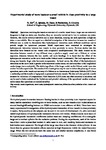Experimental study of wave loads on a small vehicle in close proximity to a large vessel
| dc.contributor.author | Xie, Nan | |
| dc.contributor.author | Iglesias, Gregorio | |
| dc.contributor.author | Hann, Martyn | |
| dc.contributor.author | Pemberton, Richard | |
| dc.contributor.author | Greaves, Deborah | |
| dc.date.accessioned | 2018-12-22T11:24:23Z | |
| dc.date.issued | 2019-02 | |
| dc.identifier.issn | 0141-1187 | |
| dc.identifier.issn | 1879-1549 | |
| dc.identifier.uri | http://hdl.handle.net/10026.1/13102 | |
| dc.description.abstract |
Operations involving the launch or recovery of a smaller vessel from a larger one are extremely dangerous in high sea states and, therefore, they are normally carried out in low to moderate sea states. However, this can be severely restrictive and in some situations, carrying out such operations in high sea states is unavoidable. Here we report on a detailed investigation of the interaction between two vessels of different size in order to characterise their hydrodynamic interaction under different conditions and to provide insight for operational purposes. Model experiments were conducted to investigate the hydrodynamic interaction between two vessels in close proximity in waves. Previous studies into this interaction have focused on two vessels with comparable size/displacement. This study focused on the interaction between vessels of very different sizes, a platform supply vessel and a lifeboat, at various separation distances between the two models and wave headings. It is found that the effect of the hydrodynamic interaction on the wave loads on the lifeboat model is substantial. The load responses show a strong non-linearity (high order harmonic components). In head waves, the effect of the hydrodynamic interaction on the wave loads is greater in the transverse modes (sway, roll and yaw) than in the longitudinal modes (surge, heave and pitch). The sheltering effects of the larger model on the lifeboat model were also evident from the experiments. The results of this investigation may be used to inform the planning of marine operations, such as the launch and recovery of a lifeboat or an Autonomous Underwater Vehicle (AUV) from a mothership and the transfer of equipment or personnel between vessels. The data will also provide a useful resource for validation of Computational Fluid Dynamics (CFD) codes and other numerical simulations, and can be used to better understand the limitations and potential widening of the operational weather windows and to ensure that operations are carried out safely. | |
| dc.format.extent | 77-87 | |
| dc.language | en | |
| dc.language.iso | en | |
| dc.publisher | Elsevier | |
| dc.subject | Model experiment | |
| dc.subject | Wave loads | |
| dc.subject | Hydrodynamic interaction | |
| dc.subject | Diffraction effect | |
| dc.subject | Radiation effect | |
| dc.subject | Launch and recovery | |
| dc.title | Experimental study of wave loads on a small vehicle in close proximity to a large vessel | |
| dc.type | journal-article | |
| dc.type | Journal Article | |
| plymouth.author-url | https://www.webofscience.com/api/gateway?GWVersion=2&SrcApp=PARTNER_APP&SrcAuth=LinksAMR&KeyUT=WOS:000457657700008&DestLinkType=FullRecord&DestApp=ALL_WOS&UsrCustomerID=11bb513d99f797142bcfeffcc58ea008 | |
| plymouth.volume | 83 | |
| plymouth.publication-status | Published | |
| plymouth.journal | Applied Ocean Research | |
| dc.identifier.doi | 10.1016/j.apor.2018.12.012 | |
| plymouth.organisational-group | /Plymouth | |
| plymouth.organisational-group | /Plymouth/Faculty of Science and Engineering | |
| plymouth.organisational-group | /Plymouth/Faculty of Science and Engineering/School of Engineering, Computing and Mathematics | |
| plymouth.organisational-group | /Plymouth/PRIMaRE Publications | |
| plymouth.organisational-group | /Plymouth/REF 2021 Researchers by UoA | |
| plymouth.organisational-group | /Plymouth/REF 2021 Researchers by UoA/UoA12 Engineering | |
| plymouth.organisational-group | /Plymouth/Research Groups | |
| plymouth.organisational-group | /Plymouth/Research Groups/Marine Institute | |
| plymouth.organisational-group | /Plymouth/Users by role | |
| plymouth.organisational-group | /Plymouth/Users by role/Academics | |
| plymouth.organisational-group | /Plymouth/Users by role/Researchers in ResearchFish submission | |
| dcterms.dateAccepted | 2018-12-17 | |
| dc.rights.embargodate | 2019-1-9 | |
| dc.identifier.eissn | 1879-1549 | |
| dc.rights.embargoperiod | Not known | |
| rioxxterms.funder | EPSRC | |
| rioxxterms.identifier.project | A Zonal CFD Approach for Fully Nonlinear Simulations of Two Vessels in Launch and Recovery Operations | |
| rioxxterms.versionofrecord | 10.1016/j.apor.2018.12.012 | |
| rioxxterms.licenseref.uri | http://www.rioxx.net/licenses/all-rights-reserved | |
| rioxxterms.licenseref.startdate | 2019-02 | |
| rioxxterms.type | Journal Article/Review | |
| plymouth.funder | A Zonal CFD Approach for Fully Nonlinear Simulations of Two Vessels in Launch and Recovery Operations::EPSRC |


